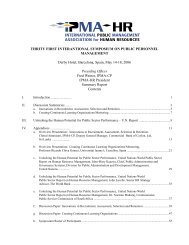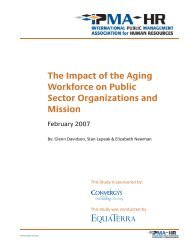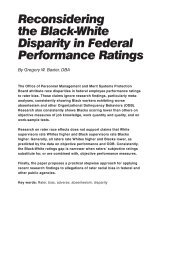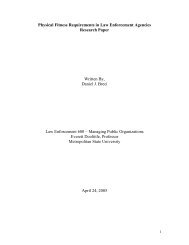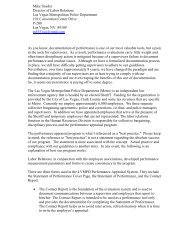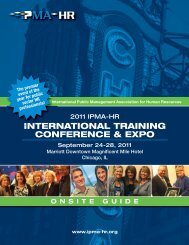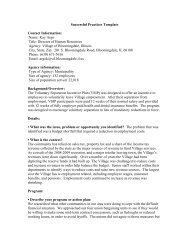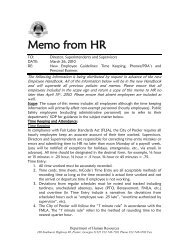Alternative Work Schedules Policies - International Personnel ...
Alternative Work Schedules Policies - International Personnel ...
Alternative Work Schedules Policies - International Personnel ...
Create successful ePaper yourself
Turn your PDF publications into a flip-book with our unique Google optimized e-Paper software.
Is There a value to <strong>Alternative</strong> <strong>Work</strong> <strong>Schedules</strong> in the <strong>Work</strong>placeTodayBy Emayeneme Gbemiye-EttaConflicts between work demands and personal life are now out in the open. It is no longermarginalized as a problem confined to working women with children. It is now recognized asa problem that concerns everyone, from senior executives to administrative assistants, to U.S.Presidents and Secretaries of State.<strong>Alternative</strong> work schedules are flexible work options set up so that full-time and/orpermanent employees can work the hours they are required to work but not in the normaltraditional manner. A flexible work schedule can be a strategic tool when implementedeffectively that leads to more loyal, dedicated and motivated staff. The Bureau of LaborStatistics reported in 2002 that 29 million full-time workers had flexible work schedules.Many believe that alternative work schedules have a positive impact on employeeperformance.There are many advantages to an employee working an alternative work schedule but, for anemployer to institute alternative work schedules, the organization also has to benefit from thearrangement. The obvious benefits are the employers’ ability to accommodate the needs ofhigh performance employees and thus retain those employees. A less obvious benefit is thedecrease in overhead costs since employees may be able to share equipment if their schedulesdo not overlap. There is also the added benefit of being able to respond to customers inanother time zone with those employees on a later work schedule. Community benefits couldinclude less pollution and traffic with fewer cars on the road.There are several types of working schedules that can be considered as being part and parcelof an alternative work schedule. These options are:Flexible Leave <strong>Policies</strong>: Systems that allow accrued sick and annual leave to be combinedfor employees’ use as they choose. <strong>Policies</strong> may include paid or unpaid personal leave time.Parental Leave: Sometimes called “family leave,” a flexible policy that provides time off foreither mothers and/or fathers to care for a newborn or very young children.Flex-Time: <strong>Work</strong> schedules that allow employees to vary their arrival and/or departure timesas long as they work a prescribed number of hours per pay period and are present during adaily “core time” (usually peak business hours).Job Sharing: Two (or more) workers share the duties of one full-time job, each workingpart-time; or two or more workers who have unrelated part-time assignments share the samebudget line.Compressed <strong>Work</strong> Week: A work schedule that enables full-time employees to work theequivalent of a full week in less than 5 days or for employees on biweekly pay schedule towork less than 10 full workdays.Part-Time Employment: Refers to temporary or permanent employees who work a portionof the regular work hours usually on average between 20-30hrs a week. Part-timeemployment has been used for a number of years by both the public and private sectors.3



